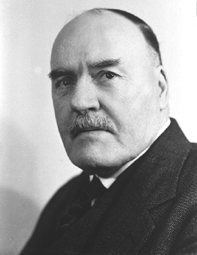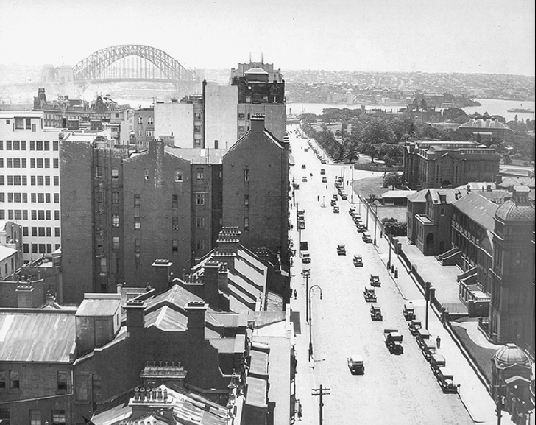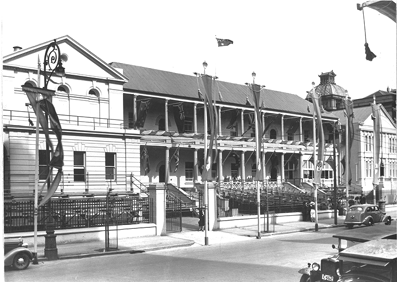The Depression, set off by the October 1929 Wall Street stock market crash, hit the New South Wales economy with great severity. Unemployment, already high at 10% in mid 1929, was 21% by mid 1930 and rising, hitting almost 32% in mid-1932. Factory output fell almost 10% in 1929-30 and another 30% in 1930-31. The Government, which had borrowed heavily for public works, also had the highest level of public expenditure in Australia, especially because of social services payments. In 1930 the budget rapidly went from a surplus to a deficit greater than all the other Australian states put together.
Accompanying this economic collapse, of course, was great social disruption and distress. Many struggled on part-time work, or depended on charity or the dole. For thousands, unemployment also meant eviction, with shanty towns of homeless people springing up in many areas. It was a crisis that governments throughout the world did not seem to how to deal with. One result of disillusionment was the rapid growth of radical or extremist political organisations claiming to defend the interests that more and more people believed democratic institutions could not provide. In New South Wales, some Communist, socialist, workers’ and unemployed organisations advocated direct action, particularly in relation to opposing house evictions; while on the right, nationalist and fascist-style organisations such as the New Guard rapidly gained in membership.
The Lang Government and the Crisis
 Premier Jack Lang
Premier Jack Lang
His radical plan for dealing with the Great Depression caused his downfall but for years afterwards loyal supporters claimed "Lang was right".
When the Nationalist-Country Party Coalition government of Thomas Bavin crumbled at the 1930 elections in the face of the Depression onslaught. J. T. (“Jack”) Lang was able to form his second Labor Government. Lang’s initial program to maintain wages and to use loans to fund public works, create jobs and generate prosperity, was frustrated by the Federal Government, the Legislative Council. The Supreme and High Courts also blocked his second attempt to abolish the Legislative Council. His 1931 ‘Lang Plan’ of inflation, reduced interest rates and loans re-negotiation was rejected by the Federal Scullin Labor Government. Lang then refused to pay loan interest and the Commonwealth commenced legal action. The NSW Labor party split into State Labor (supporting Lang) and Federal Labor (supporting Scullin). Reluctantly, Lang then agreed to the Premiers’ Plan to cut government expenditure but did little to implement it. The split in Labor ranks worsened and precipitated an early Federal election in December 1931 which was won easily by the United Australia Party led by Labor’s former Treasurer, Joseph Lyons.
The issue quickly now came to a head between the State and Commonwealth Governments with the new Federal Government regulating to take over NSW state taxes. Lang still refused to conform with the Commonwealth requirements, ordering State public servants to refuse to cooperate with the Commonwealth. On 19 March, 1932, Lang opened the Sydney Harbour Bridge (although a member of the right-wing New Guard had managed to slash the ribbon ahead of him), but this great public show of hope and achievement was the last. While hundreds of Bridge workers joined the ranks of the unemployed in NSW – now with the worst level of unemployment in Australia – Lang continued his unorthodox attempts to raise funds. On 13 May, Sir Philip Game, the Governor of NSW, determined that Lang was acting unconstitutionally, and dismissed his Government. The Opposition Leader, Bertram Stevens, was appointed as Premier and an election was called which Stevens won decisively.
The Changing Role of the Governor
In the twentieth century, the State Governor of New South Wales had been generally regarded as a ceremonial role with some constitutional functions, though not active in executive government. Governor Game’s decision to dismiss Premier Lang and call an election in 1932 was an exceptional use of the reserve powers the head of state has. The other notable example of the use of these powers in Australia occurred in 1975, when the Whitlam Federal Government was dismissed by the Governor-General.

The Governor (or Governor-General) is the representatives in Australia of the Head of State (the Monarch). Sir Philip Game (Governor from 1930 to 1935) was decidedly a British appointment, a former RAF Air-Vice Marshall. Though unelected he chose to use his powers to dismiss an elected New South Wales government. The event raises the issue of the role of the Governor in the system.
A sandstone Macquarie Street in 1930: in the distance the Sydney Harbour Bridge nears completion. Two years later the Bridge was opened by Premier Lang in Governor Game's presence; two months afterwards Game sacked Lang
The first Governors of New South Wales, faced with controlling an isolated convict colony under military rule, effectively had almost absolute power. The development of a civil court system in Governor Macquarie’s time began creating something of a balance to this. After his term of office, a small Legislative Council met from 1824 on to advise the Governor and from this developed a representative legislative body. With responsible government from 1856, the Governor no longer played an executive role in the legislative and governmental processes.
The underpinning principles of responsible government are that the Ministers sit in Parliament and are answerable or responsible to the Parliament. The Parliament and each member is responsible to the people – and the Governor's power are exercisable only on the advice of and through the Ministers responsible to the Parliament.
The role of the Head of State in New South Wales had thus become primarily formal or ceremonial, rather than as an active participant in the decisions and affairs of government. The Governor appoints the Premier and Ministry on the basis of their having sufficient support in the Lower House, presides over meetings of the Executive Council and assents to bills passed by Parliament, thus making them law. On the advice of the Government, the Governor proclaims regulations under Acts of Parliament and sets dates for the opening of, and closing of Parliamentary sessions.
Although the Governor is required, by convention, to exercise his power only on the advice of the Premier and the Ministers, there is an exception to this. In very rare circumstances, Governors can exercise "reserve" powers, discretionary powers that are kept in reserve and used only in extraordinary circumstances. Reserve powers have rarely been used and are only likely to be in times of political crisis, for example, where a government is defeated on the floor of the House in the Parliament.
Reforming the Legislative Council
As well as arousing public concern about the role of the Governor, the dismissal of Premier Lang also raised concerns about the Legislative Council's role in the State's political process. There was general agreement that Council should be reconstituted. The new Stevens-Bruxner coalition re-introduced reforms that the Bavin government attempted in 1929. A Referendum was held on 13 May 1933 at which the electorate approved an elective Council based on the system of proportional representation. The Legislative Council was now to be a House of 60 members, elected by the members of both Houses of Parliament. Members of the Legislative Council were to be elected for a term of 12 years, with 15 members (one quarter) retiring every 3 years.
The indirect method of election was favoured because of fears that the Council would rival the Assembly if it was elected on an equal mandate. Concerns were expressed that it might claim equal financial powers and be able to unmake governments. A longer term of office for Members of the Upper House was to protect parliamentary democracy from sudden swings of opinion.
Under the changes, bills for appropriating revenue or imposing new taxes (money bills) had to originate in the Legislative Assembly, and even if the Legislative Council rejected, failed to pass, or returned money bills to the Legislative Assembly suggesting amendments, the bills could still be presented for Royal Assent. If there was a deadlock between the two Houses over other types of bills, a referendum could be held.
The reconstituted Council met on 24 April 1934. Its independence was intact but it could no longer influence government monetary policy. It could delay legislation to allow time for expressions of public opinion; provide an opportunity for Ministers to tidy up Bills that may have been hastily drafted before passing the Lower House; undertake a more inquiring level of debate on Bills referred to it than often possible in the larger Lower House; act as a watchdog on the Constitution; and be a defender of minorities and the fundamentals of democracy
.
Between 1934 and 1978, however, elected Governments often found themselves confronted with a hostile Council. The replacement of only a quarter of the membership of the Council every three years meant the House would not reflect the political preferences of the majority of the electorate at any particular moment. The Labor Party continued to have its abolition as policy.
To The Eve of War

The bitterness and the split in the ranks ensured that Labor had no chance of winning the next two state elections (1935 and 1938) and for years Lang and his “Lang was Right” supporters kept the controversy alive.
The conservative United Australia Party-United Country Party coalition governments which followed Lang did little to improve economic conditions, but were fortunate that the time of their election, 1932, was the peak of the Depression and thereafter things slowly improved. Bertram Stevens retained the Premiership for a then record seven years, managing his major reform of the Legislative Council (above), largely maintaining social services (and increasing the budget deficit), providing modest relief programs and promoting private enterprise-based economic recovery. By the eve of World War II, in 1939, unemployment had fallen considerably but there were still many on the dole and little enthusiasm for government policy. Only Labor disunity had kept the government in office at the 1938 election. There was also growing dissension within government ranks and Stevens lost the leadership in 1939 to Alexander Mair who was defeated by a reunited Labor party in 1941 as the United Australia Party itself began to break up.
In 1938, on the eve of WWII, Australia celebrated 150 years since European settlement. New South Wales Parliament House prepared for the parade with bunting and temporary seating.
